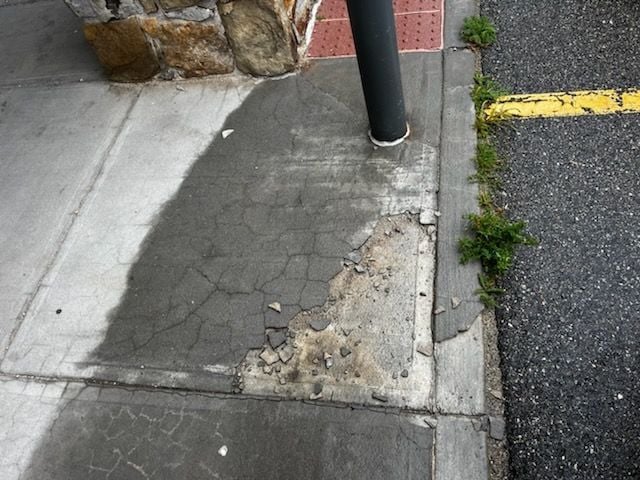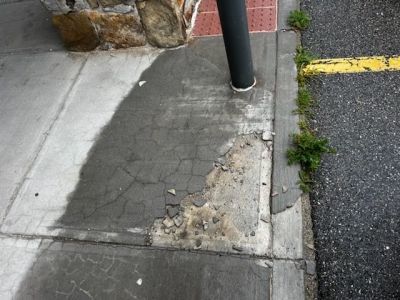
Find out whether or not concrete resurfacing is right for your deteriorating concrete.
Concrete can last decades, which is part of what makes it such a popular choice for a wide variety of applications. However, over time, concrete surfaces can become worn, cracked, or stained, diminishing their appearance and functionality.
Concrete resurfacing is often seen as the best way to remedy worn, chipped, or spalling concrete without replacement. However, while it may seem like an attractive option, it’s important to understand that it is usually only a temporary fix, especially in areas with frequent temperature and moisture fluctuations.
Here at A-1 Concrete Leveling, we’ve been repairing concrete for over 30 years, and during this time, we’ve seen the problems that can come from resurfacing concrete firsthand.
In this article, we’ll walk through what concrete resurfacing is, explore how to resurface concrete, discuss the problems that come with concrete resurfacing, and talk about when concrete resurfacing is a good idea.
What Is Concrete Resurfacing?
Concrete resurfacing involves applying a thin layer of a specialized resurfacing compound over an existing concrete surface that’s starting to show signs of wear, like minor cracking, chipping, or spalling.
The goal is to restore the appearance and functionality of the worn or damaged concrete surface, rather than demolishing the entire slab and replacing it.

Problems With Concrete Resurfacing
Concrete resurfacing is often a temporary fix for worn or damaged concrete surfaces, particularly in areas with frequent temperature and moisture fluctuations.
Adhesion
Concrete resurfacer is made with ingredients that help it stick to the existing surface, but it has its limitations. If the surface is very old, dirty, or not properly prepared, the new layer will not adhere well enough to stay put over time.
Additionally, once concrete has cured, it’s difficult for anything added on top to create a true, long-lasting bond. Bonding agents can be applied to help the resurfacer adhere to the existing surface, but it is not a guarantee that the cured resurfacer will stay in place long-term.
Freeze-Thaw Cycles
Because concrete is porous, it absorbs water, and when temperatures dip below and rise above freezing, the water freezes and thaws respectively. This freezing and thawing of water causes the concrete to expand and contract.
As the concrete below the resurfacer expands and contracts, it causes the new top layer to crack, chip, and break up. This can happen quite rapidly and is a big part of the reason why resurfacer is often a temporary solution.
Related Resource: Concrete Freeze-Thaw Cycles: Everything You Need to Know
How to Resurface Concrete
There are two primary approaches to concrete resurfacing – professional and DIY – but they both follow mostly the same steps:
- The surface is thoroughly cleaned to remove dirt, stains, and debris.
- Cracks, chips, or uneven areas are repaired using appropriate patching materials.
- Concrete resurfacing material is applied and spread out using trowels or squeegees. This overlay can be customized with various colors, patterns, and textures to achieve the desired look and slip resistance.
Professional Concrete Resurfacing
Professional concrete resurfacing is typically the more reliable option when it comes to durability and longevity.
Experienced contractors will know how to properly prepare the surface for optimal adhesion and choose the right materials for the job, which may mean a higher likelihood of the new surface lasting longer.
Professional resurfacing has limitations, and depending on the weather fluctuations where you live, professionally resurfaced concrete can still chip and crack.
DIY Concrete Resurfacing
DIY concrete resurfacing can be done using products meant for resurfacing available in hardware stores, but it is often a temporary fix.
While it may provide immediate aesthetic improvements, it is likely that the resurfacing will begin to break up relatively quickly as the temperature and moisture levels cause expansion and contraction in the concrete.
Also, without experience and know-how when it comes to concrete resurfacing, it can be hard to get the proper adhesion between the resurfacer and existing concrete, which will ultimately lead to it crumbling away.
Good Use Cases for Concrete Resurfacing
While concrete resurfacing is generally considered a temporary fix, there are situations where it can be beneficial.
It’s most suitable for surfaces that have minor cosmetic issues or surface imperfections, rather than significant structural problems. Resurfacing can provide a quick improvement in appearance and functionality, making it a good option for those on a tight budget or with short-term needs.
However, it is essential to understand its limitations and plan for the eventual need for more extensive repairs or replacement.
When Not to Resurface Your Concrete
Concrete with structural problems like heaving, settling, and deep cracks are not a good fit for concrete resurfacing.
However, heaving or settled concrete can be repaired with concrete leveling, then resurfaced once they are back to a level position.
Is Concrete Resurfacing Right for You?
Concrete resurfacing is a useful technique to temporarily enhance the appearance and functionality of worn concrete surfaces. However, concrete resurfacing is typically a short-term fix and may not withstand the challenges posed by freeze-thaw cycles or poor adhesion.
Consulting with a professional contractor can provide valuable insights and help you make an informed decision based on your specific needs and circumstances.
While we don’t perform concrete resurfacing here at A-1 Concrete Leveling, we do provide other concrete repair services to revitalize concrete, including concrete leveling, cleaning, sealing, and crack repair.
If you’re interested in seeing what these services can do for you, click the link below to schedule a free onsite cost estimate with an A-1 expert!
Want to know more? Check out these related concrete repair and maintenance topics from A-1’s online resource library, Concrete Academy:
Sarah Etler joined A-1 Concrete Leveling after receiving her Bachelor of Arts degree in English from Northern Kentucky University. As A-1's Content Marketing Manager, she works closely with industry experts to produce content that will best answer questions related to concrete repair and maintenance practices. Sarah loves living a life full of discovery and is excited every day to see what new things she can learn and share with those around her.
Topics: